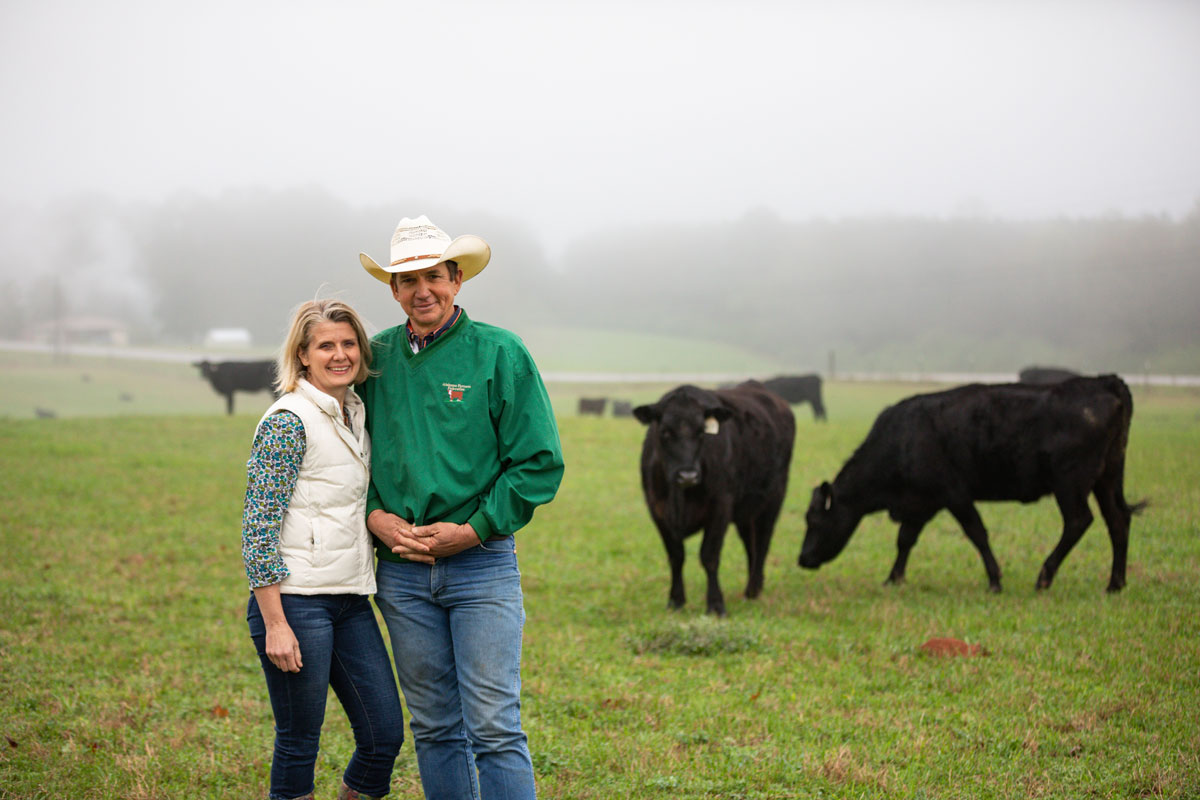
Find what works, stick to it
Alabama cattleman boosts bottom line with AngusLinkSM
by Morgan Boecker
June 15,2021
They say reputation is everything, but it’s what pays Phil Slay’s bills.
Despite not having a face-to-face conversation, the same cattle buyer has bought Slay’s calves nearly every year since 1993. Slay accurately describes the calves, and they do well at the feedyard. Integrity and performance makes a strong partnership.
In Five Points, Ala., Phil and his wife Kim manage a 150-cow commercial Angus herd and a small sheep flock. He’s a sixth generation farmer and grew up on a cattle farm and apple orchard. She’s a past chemistry teacher but now works full-time on the farm with her husband and raises greenhouse tomatoes for the community throughout the year. Together, they closely manage their bottom line.
Slay’s calves are enrolled in AngusLinkSM Source and Age and the Angus-Sired Genetics process-verified-program claims. He’s adamant about buying Angus bulls, transferring the breed papers to his name to have as much potential performance data as possible. It’s a practice that pays.
“We repeatedly earn the highest prices for our feeder calves sold in a board sale in Alabama,” Slay says. “People ask me, ‘How did you do that?’ And I tell them it’s all due to AngusLink. That program has worked for me.”
Record-keeping isn’t much of a hassle when he sees the boost on payday.
“I was getting 12 cents a pound above the average calves sold at the stockyard. It has made me money for years,” he explains. “It is pretty simple to enroll because I know which bulls breed which cows.”
Slay has sought value-added marketing routes for his feeder calve for years. He helped start the Alabama Piedmont Cattle Marketing Association in the early ’90s, worked closely with the state’s Beef Cattle Improvement Association and was an early user of AngusSource®. Along the way he’s helped Alabama and Georgia producers market their calves similarly. He wants more cattlemen to try AngusLink, promoting the value of the breed in an area not historically known for Angus.
“Phil has really embraced good Angus genetics, documentation and the value that it brings back to his environment,” says Ginette Gottswiller, American Angus Association director of verification services.
“We need more guys like Phil in the cattle business,” adds Tommy Maples, owner of Maples Stock Farm in Elkmont, Ala. “He encourages young producers and teaches the next generation ways to take up agriculture.”
Analyzing carcass data 15 years ago, Slay realized his Simmental bulls didn’t produce the quality beef he was seeking. Twenty of Slay’s calves graded Select, which fueled the transition to Angus bulls.

“Since then I haven’t bought any unregistered Angus bulls,” he says. “Now I like to work with Angus breeders that will work with me.”
Every dollar Slay spends needs to have a return. Slay even went so far as to buy second-hand bulls from a neighbor but he wouldn’t compromise the right genetics or his ability to participate in revenue-generating programs. Before he made the deal, he worked with Maples to ensure the genetics were right and he could get the registration papers transferred.
“Most cattlemen would just take the bulls,” Maples says. “But he didn’t.”
Slay receives pen information from cattle after they leave his farm, using that information to make breeding decisions and improve the herd. That is the mark of someone not willing to settle for average, Gottswiller says.
The Slays evaluate phenotype and look for average birth weight, good milk, docility and balanced maternal and carcass traits. Moderate-frame cows work best on their farm, and they patiently find suitable bulls while staying within their operation budget.
Southeast calves are stereotypically high-risk, so Slay pays close attention to herd health and follows strict vaccination protocol while preconditioning his calves.
“The last few years the feeder who received our calves has asked for more,” Kim says. “He could find bigger calves somewhere, but we really focus on disposition and health.”
They’re the kind that walk off the truck at the feedyard after 18 hours on the road and go straight to water and the bunk, she says. The calves market themselves.
During calving season, Kim keeps new mommas at a safe distance while Phil tags the calves, but most days it’s a one person enterprise. Slay checks the herd daily, feeding the weaned calves by hand while they’re preconditioned before the sale. Wild cows are not tolerated, and they select easy-going calves for the feeder.
In recent years, the buyer reports back 90% of the calves graded Choice or higher, Slay says, noting he’s always got yield grade in the back of his mind, too.
“It makes me really proud that our calves do well,” he adds. “I imagine the AngusLink folks are pretty happy that a simple guy like me can do that, too.”
Originally ran in the Angus Journal.
You may also like
You, Your Cows and Their Feed
Expert guidance from Dusty Abney at Cargill Animal Nutrition shares essential strategies for optimizing cattle nutrition during droughts, leading to healthier herds and increased profitability in challenging conditions.
Marketing Feeder Cattle: Begin with the End in Mind
Understanding what constitutes value takes an understanding of beef quality and yield thresholds that result in premiums and/or discounts. Generally, packers look for cattle that will garner a high quality grade and have excellent red meat yield, but realistically very few do both exceptionally well.
Kansas Ranchers Recognized for Sustainability Efforts
Kansas’ Wharton 3C Ranch thrives despite droughts, winning the CAB 2023 Sustainability award. The data-driven, quality-focused approach of first-generation ranchers, Shannon and Rusty Wharton, yields 100% CAB cattle. Their commitment to sustainability and industry collaboration sets a bright future for the cattle business.



